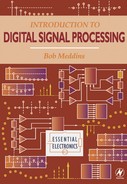Preface
As early as the 1950s, designers of signal processing systems were using digital computers to simulate and test their designs. It didn’t take too long to realize that the digital algorithms developed to drive the simulations could be used to carry out the signal processing directly – and so the digital signal processor was born. With the incredible development of microprocessor chips over the last few decades, digital signal processing has become a hugely important topic. Speech synthesis and recognition, image and music enhancement, robot vision, pattern recognition, motor control, spectral analysis, anti-skid braking and global positioning are just a few of the diverse applications of digital signal processors.
Digital signal processing is a tremendously exciting and intriguing area of electronics but its essentially mathematical nature can be very off-putting to the newcomer. My goal was to be true to the title of this book, and give a genuine introduction to the topic. As a result, I have attempted to give good coverage of the essentials of the subject, while avoiding complicated proofs and heavy maths wherever possible. However, references are frequently made to other texts where further information can be found, if required. Each chapter contains many worked examples and self-assessment exercises (along with worked solutions) to aid understanding. The student edition of the software package, MATLAB, is used throughout, to help with both the analysis and the design of systems. Although it is not essential that you have access to this package, it would make the topic more meaningful as it will allow you to check your solutions to some of the problems and also try out your own designs relatively quickly. I have not included a tutorial on MATLAB as there are many excellent texts that are dedicated to this. A reasonable level of competence in the use of some of the basic mathematical tools of the engineer, such as partial fractions, complex numbers and Laplace transforms, is assumed.
After working through this book, you should have a clear understanding of the principles of the digital signal processor and appreciate the cleverness and flexibility of the device. You will also be able to design digital filters using a variety of techniques. By the end of the book you should have a sound basis on which to build, if you intend embarking on a more advanced or specialized course.
